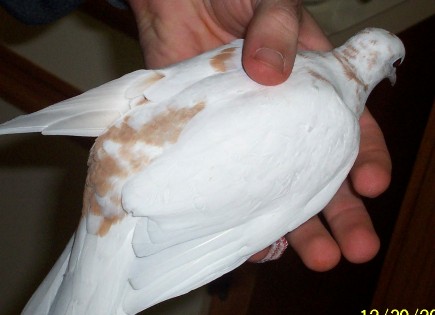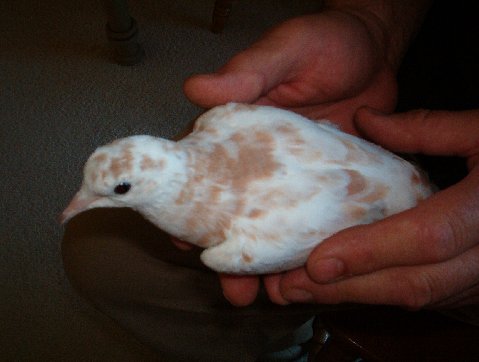
©Travis Barta
Chinmoy
pi//pi Ta//Ta

©Travis Barta

©Dan Guether (Dwight
Baker Linage)

©Dan Guenther
The above pictures are what these two breeders consider to be the "Chinmoy" as described by Abakash Konopiaty in 1985.
Note:
the Chinmoy cannot be reproduced genetically on a consistent basis. The orange
ring neck as required by the ADA description is not a genetic possibility and
can only occur when the randomness of orange spots approximates a neck ring.
The best example of an orange neck ring is in the photo of the Chinmoy owned by
Travis Barta (above top two posted pictures). But even this is not a true neck
ring, but rather random feathers approximating a neck ring. Genetically the
orange ring is not possible because the TaTa genotype will always produce a
white neck ring. Travis Barta has never been able to produce offspring with an
orange neck ring from the male in the photo. The most common expression of the
genotype pipi TaTa will be the Pearl Pied shown
under the known non-recognized colors.
(IDS agrees with the previous statement & genetic results).
The use of the name Pearl Pied is a much more descriptive term for this color.
Here is a
scanned picture of the
original flyer (B&W) published in the ADA & CDA
(courtesy
of John House with the CDA)
bulletins back in 1985.
These are the only known photos of this color.
The pictures on the flyer are what the
original description was taken
from and is quite vague
The top three pictures of an adult bird on the flyer, when closely looked at, are of the same bird (different poses); the bird does not show a full neck ring, only a partial. The one picture, with the bird's neck twisted backwards looks to show a full neck ring, but since the other spots on the bird match up with the other birds in the other two top pictures, this can only be the same bird & thus no full neck ring. Again when compared to where a normal neck ring should be, it seems the coloration is either just above or below this area. One picture even shows coloration above & below the "white neck ring". A "white neck ring" is indicative of double dose Tangerine.
I do not put any credence in the statement of the "pearled factor on the flights" of the juveniles - this facet is a juvenile facet & is even found in Wild Type juveniles (dark centers with light edging on the flights). Many Tangerine & Orange juveniles show this facet in their flights as well. This color was described at the very beginning of the introduction of the Tangerine, Orange & Pearled birds here in the US - so not much info was available on any of these new colors & their affect on other colors.